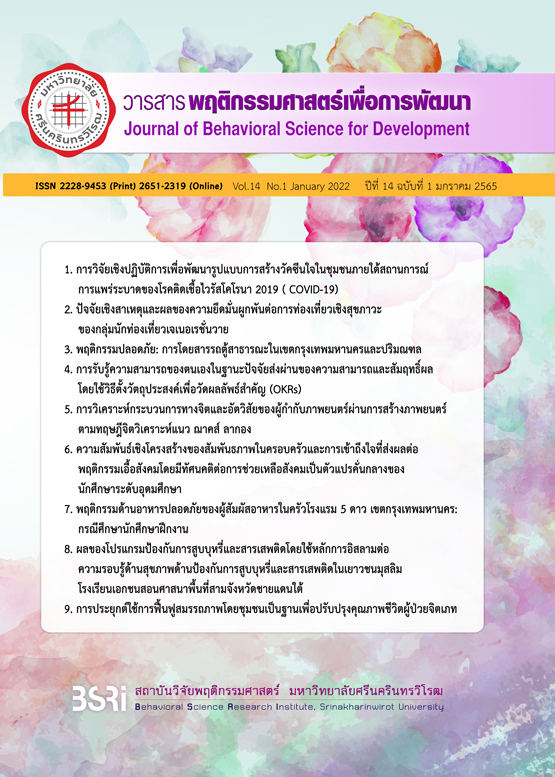Lacanian Psychoanalytic Analysis of Film Director’s Psychological Process and Subjectivity through Filmmaking
Keywords:
Jacques Lacan, Psychoanalysis, Subjectivity, Film, Film DirectorAbstract
The objective of this study was to study and analyze the film director’s subjectivity and the psychological process through a selective use of symbols in their film, based on the Lacanian psychoanalytic approach, especially on the concepts of the three orders (the Symbolic, the Imaginary, the Real) and the desire. This research employed a qualitative method, using a case study with purposive sampling. The key informants were five auteur film directors. The data was collected through secondary resources and in-depth, semi-structured interviews, and was analyzed using thematic analysis methods. The research findings indicated three crucial themes, which were the appearance of the director’s subjectivity in the film, the dynamic of subjectivity, and growth factor and healing property. These factors have shown the director attributes in expressing their identity through movies. Furthermore, the qualities change through time, including the property of mental growth. The research findings provided some suggestion to organizations involving in psychological counseling or institutes for education to acquire a knowledge of film as a piece of art which can be utilized in an approach of expressive arts therapy, and to support an intervention development and evaluate the effectiveness of using film as a part of counseling.
References
Atkins, S. S. (2003). Expressive Arts Therapy: Creative Process in Art and Life. Parkway.
Benshoff, H. M. (2015). Film and television analysis: An introduction to methods, theories, and approaches. Routledge.
Braun, V., & Clarke, V. (2006). Using thematic analysis in psychology. Qualitative Research in Psychology, 3(2), 77-101. https://doi.org/10.1191/1478088706qp063oa
Evans, D. (1996). An Introductory Dictionary of Lacanian Psychoanalysis. Routledge.
Gabbard, G. O., Litowitz, B. E., & Williams, P. (Eds.). (2012). Textbook of Psychoanalysis. American Psychiatric Publishing.
Hongthong, N. (2004). Atta bukkhon nai thatsana khō̜ng chā lākō̜ng [Jacques Lacan's Concept of the Subject] (Master’s thesis). Chiang Mai University, Chiang Mai.
Johnson, J. L., & Alderson, K. G. (2008). Therapeutic filmmaking: An exploratory pilot study. The Arts in Psychotherapy, 35(1), 11-19. https://doi.org/10.1016/j.aip.2007.08.004
Johnson, J. L. (2018). Therapeutic Filmmaking. In C. Malchiodi (Ed.). The handbook of art therapy and digital technology. Jessica Kingsley.
Lhaspajchimanandh S. (2014). Wādūai khrōngsāng thāng čhit khō̜ng chō̜ng - pō̜n læ chā lākō̜ng [On Structure of Mind: Jean-Paul Sartre and Jacques Lacan] (Master’s thesis). Khon Kaen University, Khon Kaen.
Lincharearn, A. (2015). Kān wikhro̜ læ nam sanœ̄ phon nai ngānwičhai chœ̄ng khunnaphāp [Data Analysis and presentation in qualitative research]. http://www.edu.tsu.ac.th
McGowan, T. (2015). Psychoanalytic Film Theory and The Rules of The Game. Bloomsbury.
Nastasi, B. K., & Schensul, S. L. (2005). Contributions of qualitative research to the validity of intervention research. Journal of School Psychology, 43(3), 177–195.
Sabbadini, A. (2012). Psychoanalysis and film. In G. O. Gabbard, B. E. Litowitz, & P. Williams (Eds.), Textbook of Psychoanalysis. American Psychiatric Publishing.
Saiyod, P. (2014). Kānchai sanyalak phāp thǣn rāngkāi nai ngān sinlapakam khō̜ng phinrī sanphithak læ watchaphō̜n yū dī [The Study of Body as Symbolic Representations in Art by Pinaree Sanpitak and Watchaporn Yoodee] (Master’s thesis). Silpakorn University, Bangkok.
Santasombat, Y. (1999). Fǭrǭ læ kānphatthanā kān khō̜ng čhit wikhrǫ [Sigmund Freud and the development of psychoanalysis]. Thammasatpress.
Sharon-Zisser, S. (2017). Art as subjective solution: A Lacanian theory of art therapy. International Journal of Art Therapy, 23(1), 2–13. https://doi.org/10.1080/17454832.2017.1324884
Sheikh, F. A. (2017). Subjectivity, desire and theory: Reading Lacan. Cogent Arts & Humanities, 4(1), 1299565. https://doi.org/10.1080/23311983.2017.1299565
Yansori, A. (2016, December 12). Introduction to lacanian psychoanalysis. http://psychoanalyzadnes.cz/2016/12/12/introduction-to-lacanian-psychoanalysis
Downloads
Published
How to Cite
Issue
Section
License
Copyright (c) 2022 Journal of Behavioral Science for Development

This work is licensed under a Creative Commons Attribution-NonCommercial-NoDerivatives 4.0 International License.




